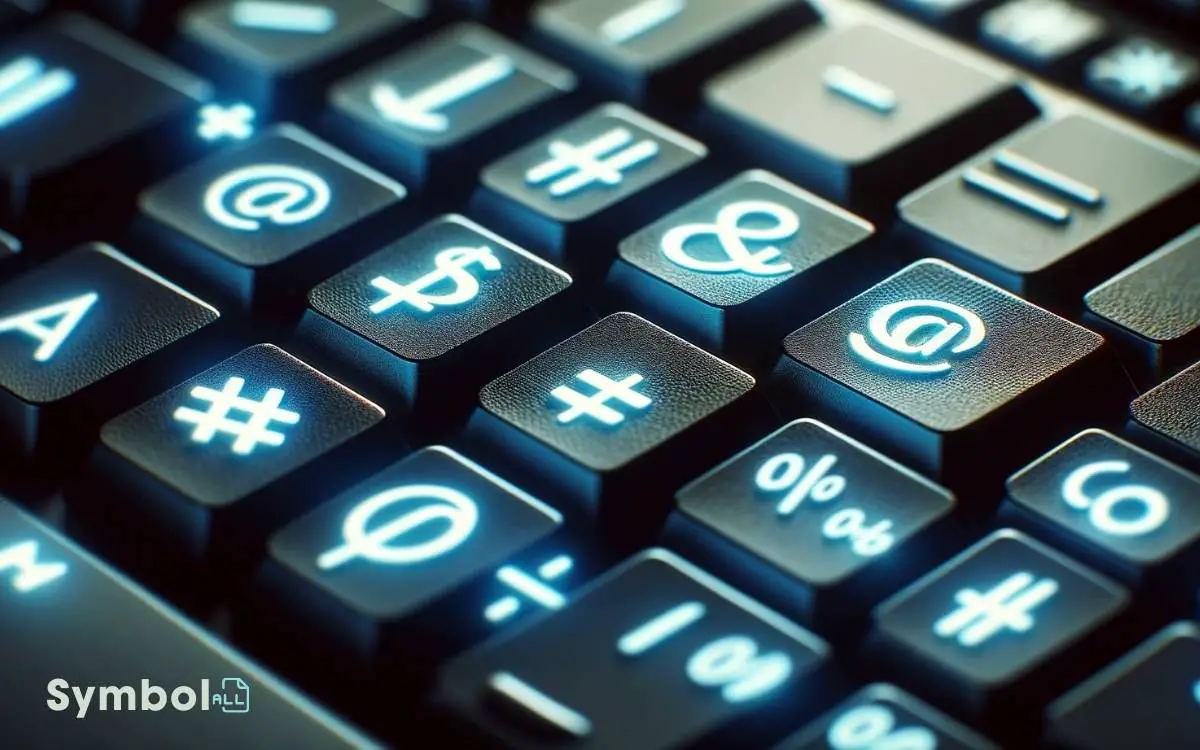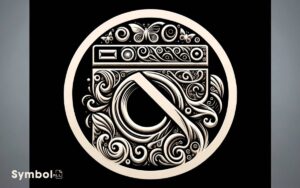How to Use Keyboard Symbols? Use The Character Map!
To use keyboard symbols effectively, start by familiarizing yourself with your layout, whether it’s QWERTY, AZERTY, or QWERTZ. Basic symbols like periods and commas can be accessed directly, while others require the Shift key.
For hidden characters, try pressing Alt (Windows) or Option (Mac) plus a specific key combination. Use the Character Map on Windows or Character Viewer on Mac to find more. Remember, symbols enhance communication across emails, coding, and social media.
Tools like asterisks (*) and underscores (_) add emphasis to your text. By mastering these tricks, you’ll make your digital content more engaging. There’s a wealth of symbols waiting for you to explore.

Key Takeaways
Understanding Keyboard Layouts
To fully grasp how to utilize keyboard symbols, it’s crucial to first understand the layout of the keyboard you’re working with. Each keyboard follows a specific design, often based on language or regional settings.
You’ve likely noticed the most common layout, QWERTY, named after the first six letters. However, there are others like AZERTY or QWERTZ, primarily used in different parts of Europe.
Understanding your keyboard’s layout allows you to efficiently find and use symbols. Most symbols are located on the upper part of the keys and can be accessed with the Shift key.
Some keys, like Ctrl, Alt, and Shift, serve as modifiers that change key functions, allowing for a broader range of symbols. Familiarizing yourself with these aspects ensures you’re not lost when searching for specific symbols.
Basic Symbols and Their Uses
Understanding the basic symbols on your keyboard is vital for enhancing your typing efficiency and accuracy. Symbols like the period ((), comma (,), and question mark (?) are essential in creating clear, coherent sentences.
The period signifies the end of a statement, while the comma indicates a pause or separation of ideas. The question mark, of course, denotes a question.
Parentheses () are used to include additional information or clarify, and the hyphen –-connects words or separates syllables in a compound word. The equal sign (=) and plus (+) are key for basic arithmetic operations, indicating equality and addition, respectively.
Mastering these symbols is essential for effective communication, whether you’re composing an email, drafting a report, or engaging in online chats.
Accessing Hidden Symbols
Beyond the basic symbols you’re familiar with, there’s a whole array of hidden characters on your keyboard waiting to be discovered and utilized. These often-overlooked elements can enhance your typing, add flair to your documents, and even improve clarity in academic writing. For instance, learning to access em dashes, curly quotes, or the symbols for effective footnote usage can elevate the professionalism of your work. With a bit of exploration, you’ll uncover a treasure trove of characters that can make your writing more precise and engaging.
To access these, you’ll often need to use a combination of keys. For Windows users, pressing the ‘Alt’ key followed by a sequence of numbers on the numeric keypad can reveal a variety of symbols. On Macs, pressing ‘Option’ plus another key can unveil hidden characters.
Additionally, both operating systems have a Character Map (Windows) or Character Viewer (Mac) tool that lets you explore and copy an extensive selection of symbols.
Remember, the specific combinations vary, so exploring these tools or a quick online search can reveal the full potential of your keyboard’s hidden symbols.
Special Characters for Social Media
Why not elevate your social media posts with special characters that can make your content stand out? Adding symbols can express your emotions and thoughts more vividly, making your messages more engaging.
Here’s a quick guide to using special characters that resonate with your followers:
| Symbol | Emotion/Use |
|---|---|
| ❤️ | Love/Passion |
| 😂 | Laughter/Joy |
| 🚀 | Growth/Excitement |
| 💡 | Idea/Inspiration |
| ✨ | Magic/Highlight |
Incorporating these symbols into your posts can help convey feelings and ideas that words alone might not fully express.
Whether you’re tweeting, updating your status, or captioning a photo, sprinkling in a few well-chosen special characters can make your content more relatable and share-worthy. Give it a try and watch your engagement grow!
Symbols for Coding and Development
In the world of coding and development, symbols act as essential tools that streamline processes and enhance clarity in your work.
Curly braces `{}` define blocks of code, distinguishing functions or logical chunks.
Square brackets `[]` often denote arrays or list structures, critical for organizing data.
Parentheses `()` aren’t just for mathematical operations; they also dictate the order of operations and enclose parameters in function calls.
The semicolon `;` marks the end of a statement, signaling the compiler or interpreter to execute the instruction before moving on.
Meanwhile, the equal sign `=` assigns values, but in comparison operations, you’ll need double equals `==` or the strict `===` to ensure type and value integrity.
Mastering these symbols is key to writing efficient, error-free code.
Keyboard Shortcuts for Efficiency
Mastering keyboard shortcuts can greatly boost your coding efficiency, allowing you to navigate and edit your work faster than ever.
For instance, `Ctrl + C` and `Ctrl + V` let you copy and paste with a flick of your wrist.
Need to find a specific line or command? `Ctrl + F` becomes your best friend, quickly bringing you to the needed text.
If you’re juggling multiple files, `Ctrl + Tab` switches between them seamlessly, saving you precious seconds.
And don’t forget `Ctrl + Z` for those moments when you need to undo an action.
Troubleshooting Common Issues
When you’re typing and notice symbols aren’t appearing as they should, it’s important to identify the root of these errors.
If your keys become unresponsive, there are effective methods to fix them.
This section will guide you through resolving these common issues, ensuring your keyboard functions smoothly again.
Identifying Symbol Errors
You’ll often encounter symbol errors that can disrupt your typing flow, requiring immediate troubleshooting. Recognizing these errors early on is essential for maintaining your productivity.
Here’s a quick guide to help you identify common symbol errors:
| Error Type | Possible Indicator |
|---|---|
| Wrong Symbol Output | Symbols do not match keys pressed |
| Repeated Symbols | Same symbol appears multiple times |
| Missing Symbols | No symbol appears when a key is pressed |
| Incorrect Case | Upper case instead of lower case symbols, or vice versa |
| Delayed Output | Symbol appears after a noticeable delay |
Understanding these indicators will help you quickly identify what’s going wrong with your keyboard’s symbol function. Remember, recognizing the problem is the first step towards finding a solution.
Fixing Unresponsive Keys
Encountering unresponsive keys can be frustrating, but there are effective strategies to troubleshoot and resolve these common issues.
Here’s what you can do:
- Verify your keyboard’s connection to make sure it’s securely plugged in or properly connected via Bluetooth.
- Reboot your computer to clear any temporary software glitches that may be affecting the keyboard’s functionality.
- Clean the keyboard gently with compressed air or a soft brush to remove dust and debris from under the keys.
- Update your keyboard drivers through your device’s operating system to make sure you’re using the latest software.
- Try using the keyboard on another computer to determine if the issue is with the keyboard itself or your computer.
Expanding Your Symbol Vocabulary
Now that you’re comfortable with the basics, it’s time to expand your symbol vocabulary. You’ll learn to master shortcuts for quick access.
Discover uncommon symbols to enrich your texts, and explore ways to enhance emphasis through strategic symbol use.
This knowledge won’t only speed up your typing but also add flair and precision to your written communication.
Symbol Shortcuts Mastery
Mastering symbol shortcuts can greatly expand your typing efficiency and symbol vocabulary. Getting familiar with these shortcuts doesn’t just make you faster; it makes your work look more professional and polished.
Here’s how you can start:
- Alt + 0153 for the trademark symbol (™)
- Ctrl + Shift + u, then 20ac for the Euro (€)
- Alt + 0176 for the degree symbol (°)
- Ctrl + Shift + 2 for the at symbol (@) in some layouts
- Alt + 0145 and Alt + 0146 for left (‘) and right (‘) single quotation marks
Exploring Uncommon Symbols
Having explored the basics of symbol shortcuts, let’s expand your repertoire by introducing more uncommon symbols that can elevate your typing game.
Start with the interrobang (‽), a hybrid of a question mark and an exclamation, perfect for expressing disbelief or shock in a quirky manner.
Then, there’s the pilcrow (¶), signaling a new paragraph or section, essential for detailed text structuring.
Don’t overlook the section sign (§), used to reference specific sections in documents, making legal and academic writing more precise.
For mathematicians and scientists, the degree symbol (°) and the multiplication sign (×) are invaluable for expressing temperature, angles, and calculations efficiently.
Mastering these symbols not only enhances your typing but also enriches your written communication, allowing for clearer, more nuanced expression.
Enhancing Text Emphasis
Expanding your symbol vocabulary can dramatically enhance text emphasis, making your written communication more impactful. By integrating a variety of keyboard symbols, you’re able to convey tone, importance, and emotion more effectively.
Here’s how you can do it:
- Asterisks (*) for *italicizing* words to show emphasis or denote titles.
- Underscores (_) around words for _underlining_ without the line, suggesting significance.
- Tildes (~) for striking through words, ~like this~, to indicate correction or irrelevance.
- Greater than (>) for block quotes, highlighting someone else’s words.
- Backticks (`) around words for `code snippets`, making technical text stand out.
Conclusion
Now that you’ve navigated the maze of keyboard symbols, from the basics to the more obscure, you’re equipped to enhance your digital communication and efficiency. Remember, ‘practice makes perfect.’
By incorporating these symbols into your daily typing, you’ll not only speed up your workflow but also add flair to your social media and coding projects. If you ever hit a snag, revisit these tips.
Expanding your symbol vocabulary is a journey, not a sprint, so keep exploring and experimenting.






